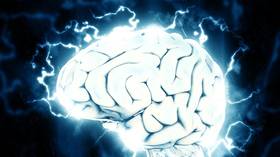Brain's tsunami-like mechanism may foreshadow migraines, but non-drug therapy could reduce need for opioids, research finds

Migraine researchers have observed a tsunami-like phenomenon sweeping across mice brains just prior to the potentially blinding headaches, which could improve upon existing treatments and potentially help find a cure.
Glutamate is a kind of chemical messenger which excites nerve cells across the brain, and is known to have some association with migraines.
Auras, which can accompany certain kinds of migraines, include symptoms such as flashes of light, temporary loss of vision, tingling in the hands or face just prior to the onset of a migraine.
Researchers at the University of Utah have detected a veritable tsunami of the brain-signaling molecule glutamate which may explain the onset of auras and help unlock the underlying mechanism in a slew of numerous brain disorders from migraines to stroke, epilepsy and even traumatic brain injuries, among others.
“This is something new.... Glutamate plumes are a completely new mechanism of migraine, and it's a good bet that they are players in other diseases of the nervous system,” says K.C. Brennan, a neurologist from the University of Utah.
Also on rt.com Historic 1st: FDA calls for opioid to be removed from market based on risk of abuseThe scientists observed these tsunamis of glutamate traveling across the brains of mice, in tandem with previously witnessed shifts in brain activity associated with the condition, just prior to the onset of migraines.
Understanding the exact mechanism which causes migraines is vital to find a cure or at the very least developing more effective treatments, especially given that symptoms include pain, nauseas and even vomiting.
A phenomenon called spreading depolarization, a period of extreme, runaway activity in the brain, is also thought to play a significant role in the onset of not just migraines but in other conditions like stroke and brain seizures.
The University of Utah researchers conducted experiments with mice whose brains were genetically modified to both produce migraines with auras and had their glutamate transport processes altered. The researchers also added a form of dye which allowed them to image the brains while the mice were awake.
They observed split-second ‘plumes’ of glutamate moving outwards from a central point atop the brain. These plumes then triggered an outward, tsunami-like chain reaction which swept across the neurons.
To make matters worse, the researchers observed that astrocytes, cells which clean up the brain, were extremely slow in reacting to and managing the spike in glutamate.
This tsunami of glutamate confirms previous suspicions about the underlying mechanism behind migraines but therapies targeting glutamate production have so far yielded mixed results. Additional research only helps to complete the picture of what exactly makes migraines so miserable and how scientists might be able to stop them once and for all.
In the interim, a recent clinical trial from Wake Forest Baptist Health which examined the efficacy of mindfulness-based stress reduction (MBSR) techniques and other non-drug based therapies yielded surprising results.
Also on rt.com ‘We’ve never seen that before’: Experiment with drug Ketamine reveals possible ‘reset button’ inside the brainResearchers led by Rebecca Erwin Wells, associate professor of neurology at Wake Forest Baptist Health, examined the migraine outcomes, pain perception and measures of emotional well-being among 89 adults with a history of migraine, whom they split into two groups.
One group underwent MBSR technique classes while the other took headache education, both for a period of eight weeks.
The MBSR group were encouraged to continue their practice at home while the other group were trained on pathophysiology, triggers, stress and treatment for migraines.
Both groups reported fewer days of migraines after the eight weeks had concluded but only the MBSR group recorded lessened disability, reduced depression, better emotional well-being and improved overall quality of life.
“At a time when opioids are still being used for migraine, finding safe non-drug options with long-term benefit has significant implications,” said Wells.
Like this story? Share it with a friend!













